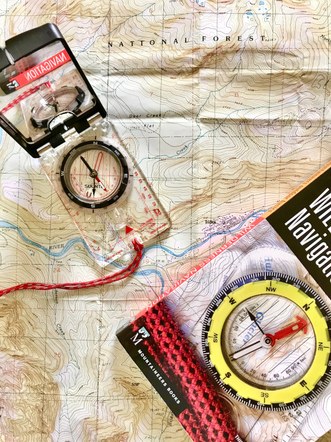Seattle Wilderness Navigation Equivalency
Equivalency is appropriate for members who have a well grounded grasp of core concepts, and are proficient with paper map, compass, altimeter, and GPS.
NOTE: Graduates of the Wilderness Navigation Course whose Basic Navigation Badge has not expired can follow the Wilderness Navigation Rebadge process.
Required Core Navigation Skills
You will be required to teach your assessor (who will assume the role of a beginning student) various core navigational concepts and techniques. This may include how to:
Deduce the angle of a slope using the clinometer.
Calculate “grade of slope” on a paper map without using trigonometry.
Use a mirrored compass with no declination adjustment in combination with a paper map to deduce your point position relative to a recognizable feature in the field.
Use a mirrored compass with no declination adjustment in combination with a paper map to locate and identify an objective in the field.
Orient a paper map using only the sun, time of day, and/or terrain recognition.
Orient a paper map using a mirrored compass.
Convert a true bearing into a magnetic bearing based on your declination being east.
Convert a true bearing into a magnetic bearing based on your declination being west.
Convert a magnetic bearing into a true bearing based on your declination being east.
Convert a magnetic bearing into a true bearing based on your declination being west.
Accurately communicate UTM coordinates.
Demonstrate how to obtain a GPS coordinate and transfer it to a paper map.
Should you pass this assessment, you would then be required to:
- Attend an instructor training session at Discovery Park (a weekend event from 7:30am to 2:30pm), to familiarize yourself with the field trip particulars and our best practices.
- Instruct at an In-Person Workshop for the Wilderness Navigation Course.
- Instruct at a Field Trip for the Wilderness Navigation Course.
The Application Process
- Read the Seattle Wilderness Navigation Course description carefully.
- Read the Required Core Navigation Skills section on this page carefully.
- Sign up and pay the registration fee for Seattle Wilderness Navigation Equivalency.
- To prequalify for the in-person assessment, submit an application to the Seattle Equivalency Lead (click here to apply). You will then be advised of next steps. (2 hours)
- Attend an in-person assessment (2 hours)
- Held once a quarter, generally the last month of the quarter on a weekend. Pre-qualification is required.
- To successfully pass the assessment, you are required to teach, at a minimum, the skills listed above in the Required Core Navigation Skills section on this page.
- Should you pass the assessment, you must complete the following activities to earn the Basic Navigation Badge (all are weekend activities held from 7:30 AM to 2:30 PM):
- Attend an instructor training session at Discovery Park to familiarize yourself with the field trip particulars and our best practices. (7 hours)
- Instruct at an In-Person Workshop for the Wilderness Navigation Course. (7 hours)
- Instruct at a Field Trip for the Wilderness Navigation Course. (7 hours)
Need more help or have questions
If you find these skills or this process challenging, consider the Seattle Wilderness Navigation Course to earn the Basic Navigation Badge. The course is popular and offers an opportunity to refresh your skills and connect with others.
Contact Seattle Equivalency Lead.
